
An Interview with Turkish Artist Gülçin Anmaç A Modern Master in Traditional Islamic Art
Jun 18, 2017 Interview

This article is a part of the project 'Promotion of the Ottoman Cultural Heritage of Bosnia and Turkey' which is organized by Monolit, Association for Promoting Islamic Arts and supported by the Republic of Turkey (YTB - T.C. BAŞBAKANLIK Yurtdışı Türkler ve Akraba Topluluklar Başkanlığı / Prime Ministry, Presidency for Turks Abroad and Related Communities).
 Gülçin Anmaç / Courtesy of the Artist
Gülçin Anmaç / Courtesy of the Artist
I was born in Germany, grew up in Turkey. I graduated from the Department of Social Anthropology, Faculty of Literature, Istanbul University. I worked as a consultant in our company over years. Meanwhile, the love for art in my heart did not let me alone, I was constantly drawing and designing something. I took art history courses from painter Özdemir Altan and painting classes from painter Mahir Güven for some terms. My professor said I could be good in classical art because I could draw and paint lines finely and that is how I learned about Classical Turkish Arts. I liked this type of arts and started my works of ‘tezhip’ with Cahide Keskiner. I continued this art by participating in the special program organized by the Ministry of Culture and Tourism. My professor Nusret Çolpan held lectures and I had courses on miniature and worked together with him until he died.
University education is more than vocational, it provides something more important; a vision and a perspective on life. I carried out my master’s study on ‘Protecting Cultural Properties’ in Kadir Has University and wrote a thesis on ‘Protecting the Intangible Cultural Properties’ to combine my previous university education with the education on cultural art. I participated in over a hundred of exhibitions in different cities and abroad; had solo exhibitions, my works on miniatures were published in more than fifty different books. I received the right to be an expert of intangible cultural properties and an artist of Turkish traditional art. I designed several works for some documentary films, animations, magazines books, brochures, tile works, jewellery, and miniatures for different projects. I am currently carrying on my work in art and I teach miniature in my workshop in Istanbul.
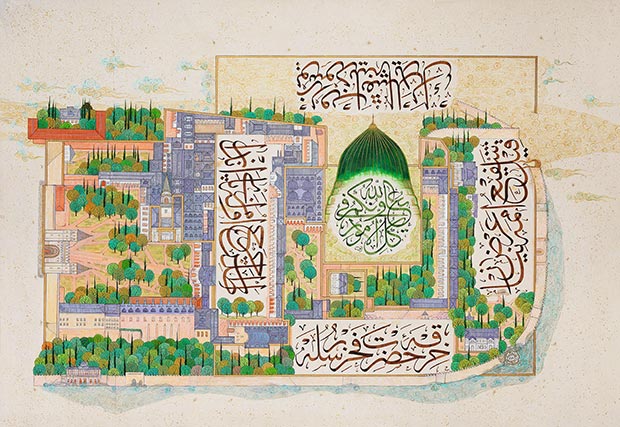 Gülçin Anmaç, miniature / Courtesy of the Artist
Gülçin Anmaç, miniature / Courtesy of the Artist
My biggest advantage is to have two big artists as my masters. I learned number of things by being with them such as the traditional structure, customs and manners, the rules of the work, historical knowledge, a broad perspective and vision of art and to have a unique work. The professor and master of these two masters of mine was distinguished professor Süheyl Ünver who made a great effort for keeping Turkish traditional arts alive, institutionalized them while they were ‘dying arts’.
My distinguished master is Cahide Keskiner who made a great contribution to the field. Beside her work on miniature, she published various books on tezhip and miniature. I learned all the details from Nusret Çolpan, my late master and teacher, whom I can call 'a painter of city'. He made various unique works of art and reached large masses by panting it, on porcelain, wall, and large scale tiles. He brought a different perspective to our art and open the door for us courageously.
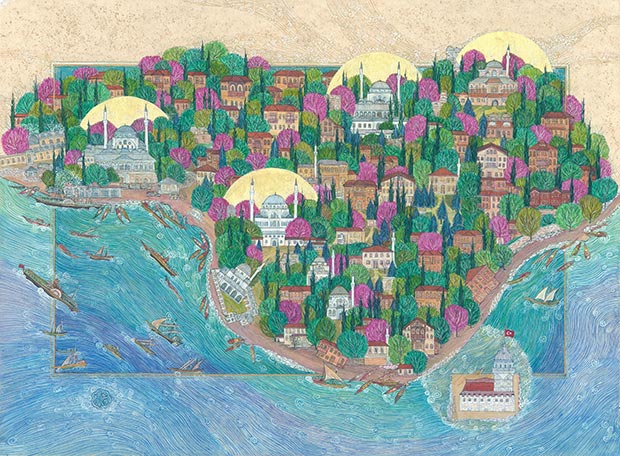 Gülçin Anmaç, miniature, Űsküdar ve dört hanım sultanın yaptırdığı külliyeler (Uskudar mosque complex built by the Sultan's wife) / Courtesy of the Artist
Gülçin Anmaç, miniature, Űsküdar ve dört hanım sultanın yaptırdığı külliyeler (Uskudar mosque complex built by the Sultan's wife) / Courtesy of the Artist
I started learning our traditional arts by learning tezhip/gilded for about six years. One can learn number of techniques in tezhip/gilded education such as drawing classical motives, creating compositions, all the technical rules of traditional art, muraqqaa and polishing, use of brush, dye and gold. In fact, it is important to obtain the knowledge of common craft/art and history before starting all traditional art education. I am dedicated in providing knowledge of traditional art initially in my own teaching. I preferred miniature while learning and practicing traditional art because I like painting most; during the time when I practiced tezhip/gilded and tile, miniature was my main art. Because during the art related work time I admired miniature. It is a kind of art that is telling about us. It is such a pleasure to reinterpret the ability of old knowledge and art with a new and unique composition. I do love explaining perspective of cities, historical facts and events or legends and folk tales with the help of miniatures.
Everything is restricted with lines, all objects are contoured with lines and painted either as small or big objects based on their importance. In general, there is an aerial viewpoint in miniature but, objects are presented as front view and they are focused as independent and individual figures. Sometimes, some important objects or figures such as a Sultan are displayed bigger than the others. Perspectives, light and shade cannot omit in miniature however, there are periods. Lack of perspective is not a deficiency, it provides the advantage of displaying all the details. A contemporary view is the ability to see the object as it is and this look is in miniature. The main component shaping the depth of miniature is not perspective, it is the richness of details and the work.
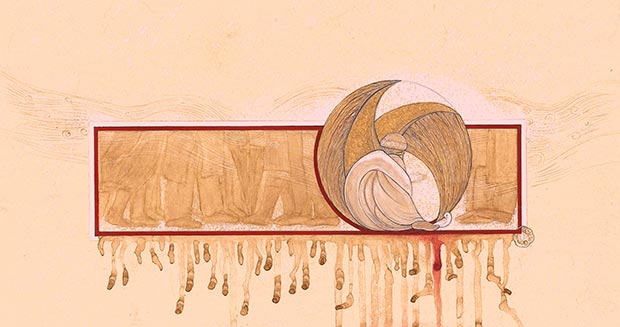 Gülçin Anmaç, miniature, Mülteci (Refugee) / Courtesy of the Artist
Gülçin Anmaç, miniature, Mülteci (Refugee) / Courtesy of the Artist
Turkish classical art is based on and fed by Islamic art and philosophy. I can draw a figure to construct a story however, hesitate to flesh out the story. I can tell my story with inanimate and even stylized figures without providing depth and the effect of light and shade. This perspective is an accepted and even adopted approach. In classical art for instance, a bird figure is extremely stylized and formed into rumi motive so in fact loses its root and is formed to be more often used as one of the items in tezhip and architecture. Here, we see the naivety of not practicing idolatry and this is considered carefully in Islamic art in all means of practicing.
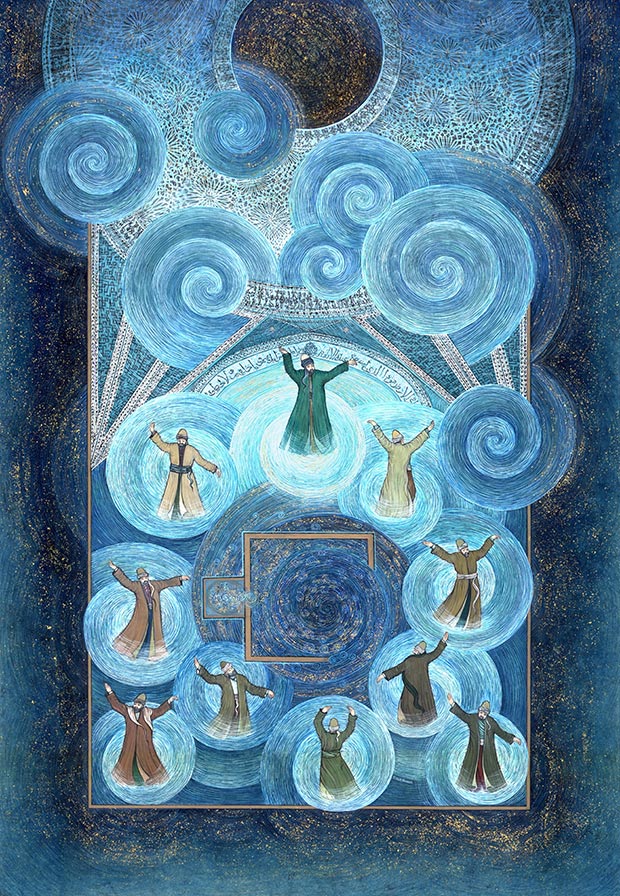 Gülçin Anmaç, miniature / Courtesy of the Artist
Gülçin Anmaç, miniature / Courtesy of the Artist
Yes, if you want to have a unique piece of art it is required. In the art of miniature in our tradition, using historical facts is a common practice. For instance, there were some special painters called ‘nakkaş’ who were keeping a written record and were painting while the Ottoman army was carrying a campaign of war. It was a very important work when there were no option of photography and it was equally important to keep the records correct. Now, the specific period is studied with all the features and carefully focused for a work. When I do work on a place or space I am very careful about having all the architectural items in the right place. Rework and information gathering sometimes takes longer than the painting itself. If it is a historical subject or figure, I gather all data and visual items, I analyze them and finally I start working on them. Miniature is a unique work that belongs to us, while coming from the past. It is also an art through which we can express ourselves to other cultures. I create my art pieces by feeling this.
One must understand the logic and rules of the classical art by analyzing art works of previous periods. Then, miniature works of different schools and approaches of previous periods are copied, and when the difference in composition and painting techniques are understood, then one can develop their talent. When you try to produce some unique work, it is like being on a knife-edge; the miniature you try to produce can easily turn into a naive painting, an illustration, graphic design or a copy. What is required for this art is knowing the features of traditional art of painting and drawing, having the distinction of nakkaÅŸ, comprehensive knowledge of the work and the talent to produce unique art works. These realities tell us the reason of having not many artists in miniature and why there are many who just copy the existing ones. It has been always very important to have a master with a broad vision and depth of knowledge for making this type of art and for understanding it correctly. Miniature can be learned with the master and apprentice relations just like any other traditional arts. The process of learning and developing yourself is difficult and a qualified master is essential for such type of art.
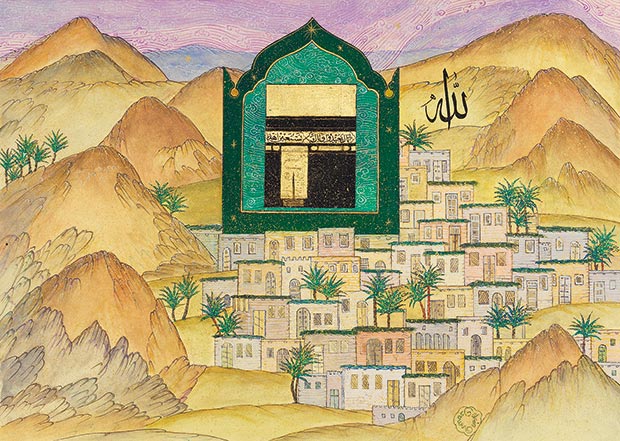 Gülçin Anmaç, miniature, Kâbe-i Şerif ve Eski Mekke şehri (Kaaba and old city of Mecca) / Courtesy of the Artist
Gülçin Anmaç, miniature, Kâbe-i Şerif ve Eski Mekke şehri (Kaaba and old city of Mecca) / Courtesy of the Artist
Art is combined with a soul. What makes our heart soft is where the soul is thinning, we produce with the soul not with the mind. Art, for me, is my breathing zone, the way I explain myself, the reason for my existence on this planet, and a reason to have a positive touch on other lives.
Comments
Add a comment